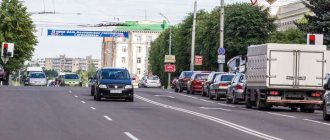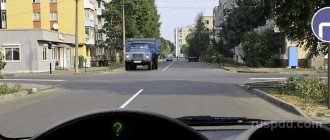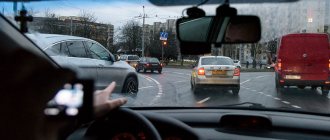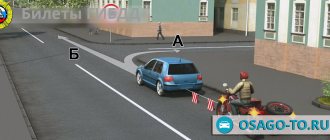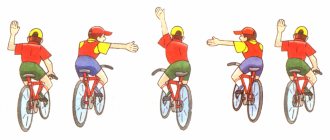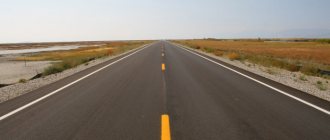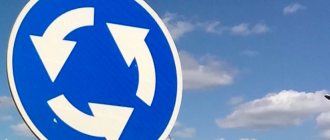Definition
Reversing traffic is a forced, organized measure, the purpose of which is to relieve the number of cars on part of the road. Such actions reduce the time required to get to a specific point and increase the throughput of the roadway.
Lanes intended to relieve road congestion are characterized by a higher level of danger, which can provoke an emergency situation.
Most often, such a traffic system is encountered during road repair work. The reverse is organized by representatives of the traffic police or workers involved in road surfaces.
Reversing traffic is advisable specifically on those road sections where traffic flows in different directions have uneven intensity. This is relevant for rush hour, repair work on the road or an accident on a specific part of it. Most often, stripes are found at exits from large populated areas, where the flow of cars is mainly directed outside the city.
Expert opinion
Evgeniy Romanov
Lawyer, specializes in protecting rights in areas related to traffic rules, insurance and disputes with the traffic police.
This type of movement has been used for quite a long time in Europe, Australia, and the USA. In our country, it still has a lot of shortcomings. There are many organizational issues that prevent us from achieving the final positive result. Taking into account the specifics of the system of traffic rules and the driver's mentality in our country, it can be argued that the accident rate on such roads is very high.
The introduction of reverse causes a lot of controversy among drivers. However, despite some difficulties in organization, reverse movement does make it possible to increase the speed of vehicles in the general flow. At the same time, the number of cars in different directions does not increase. To increase the number of reverse lanes in the Russian Federation, a number of measures are required aimed at increasing discipline among drivers.
The main requirement is to reduce the accident rate on reverse sections. Drivers are required to have maximum concentration. The car owner must be precisely aware of the extent of his responsibility and adhere to existing rules. This makes it possible to minimize the number of accidents on a specific part of the road. Particular caution is required when turning right, as well as when changing lanes at an intersection. You can change to a reverse lane only within the visibility range of a traffic light.
Methods for organizing reverse movement
To organize reverse traffic, you need to install a special road sign that will warn drivers about this. For the same purpose, markings are applied to the road or a traffic light is installed.
Road markings
The row for reverse movement is divided by markings 1.9. It consists of two broken parallel lines, the interval between which is 3:1.
The disadvantages of this method include that when there is snow outside, it can be difficult to see the markings. In addition, over time, the lines may fade.
One centrally located line forms two rows where the machines reverse. If the markings are marked on both sides, there will be one reversible lane on the road.
Traffic signals
The use of a special signaling device - a traffic light - is another way to organize reverse traffic. A traffic light usually has 2 or 3 fields. The following symbols can be seen on them:
- Green downward arrow. Gives permission to drive in the appropriate lane.
- Yellow arrow pointing to the lower right corner. It is a sign that you need to leave the lane, changing it to the adjacent one.
- Red Cross. Prohibits movement.
A reversible traffic light is installed on a specific lane of the road. Its operation does not apply to the entire road or intersection. It works exclusively for those cars that move along the lane over which it hangs.
Special characters
When entering a reversible lane, the driver should see signs that indicate this. These include the following signs:
- Sign 5.8. It looks like an image of a connected arrow with up and down direction indicators. Indicates the beginning of the reversible stripe.
- Sign 5.9. It looks like the previous sign crossed out with a red line and indicates that the part with reverse is ending.
- Sign 5.10. Represents white arrows that are located horizontally and point to the left and right directions. The indicator is a warning about the start of movement in reverse. You can see it only before the intersection.
Parapets
Accidents on the roads are largely due not only to congestion, but also to the fact that there are not enough traffic lights and markings to ensure correct reversing traffic. Therefore, parapet-type blocks made of concrete structures can additionally be used. They fence off free lanes on the opposite side of the road, which makes it possible to increase the speed of cars during peak loads.
Parapets are installed on the road and secured with rubber pads. Fences can have constant or variable length. Parapets of variable length are made of steel and are a welded structure. The use of such mobile blocks ensures that the road markings are divided into sections for reverse traffic.
Reverse traffic rules
There are two main types of traffic organization on such roads:
- If the reverse stripe is marked on both sides with special markings, which look like two wide broken white lines. In this case, movement must be carried out according to traffic lights according to the general rules. After leaving the lane, the driver must change lanes to the right of the reverse lane.
- If there is a special marking in the middle of the road, which looks like two wide broken white lines. In this case, two lanes can be used for reverse traffic, which are located to the right and left of this marking. It should be understood that traffic on such lanes in the presence of traffic lights is carried out only in one direction.
Malyshev Sergey Petrovich
Major of the traffic police special regiment for St. Petersburg
Ask a Question
For example, there is a road with 4 lanes, and in the middle of the road there is a special marking indicating the presence of reverse traffic, in which case 3 lanes will be used for traffic in one direction. If there are markings, but the traffic lights are not on (there is no permissive or prohibiting signal), then traffic is carried out in the usual direction (in the case of our example, 2 lanes will be used for traffic in one direction, 2 other lanes will be used for traffic in opposite direction).
Advantages and disadvantages of reverse strips
Reversing movement provides the following advantages:
- Thanks to reverse, traffic on the roads is coordinated.
- In large cities, reversing traffic is indispensable for reducing traffic congestion.
- A lane with similar traffic can be used at specific times of the day, weekdays or weekends.
- Vehicle speed can increase by 20%.
However, there are also some disadvantages:
- Emergencies in such areas occur more often than in ordinary ones.
- In our country, the reverse system is not so widespread, so the driver may get confused and not understand how best to behave.
Definition of reverse movement
Reversible traffic is a special mode of traffic organization in which vehicles at different periods of time can move along special reversible lanes, both in one direction and in the opposite direction. Such lanes are marked with special signs and road markings, and traffic on these lanes is regulated by reversible traffic lights.
Malyshev Sergey Petrovich
Major of the traffic police special regiment for St. Petersburg
Ask a Question
Reversible lanes are usually used to avoid traffic congestion at different times.
For example, in the morning, many people go to work from the suburbs to the city - in this case, it is beneficial to allocate an additional lane for them, and in the evening these people will return home - then it will be reasonable to change the direction of travel to avoid traffic jams.
Traffic rules for reversible sections
Compliance with traffic rules will help you avoid road accidents and fines. It is extremely important to adhere to them due to the fact that the reversible part of the road is characterized by an increased accident rate.
Entering the lanes
Driving into the reversible lane is permitted if the following conditions are met:
- The presence of a working traffic light where the color is green.
- Installed sign 5.8.
In the second case, it is important to look at the pointer that is located near the symbol. So, under 8.5.1, you can enter the strip only on holidays and weekends. In the absence of an auxiliary sign, the traffic light will serve as a guide, or a traffic controller should be located in this area.
If there is no prohibition, then you can enter the driving lane in any direction from all directions. You can only leave it in the far right lane.
At the traffic light
Reversing traffic is characterized by a special traffic light. Usually it has two signals - green and red. Red prohibits entering a lane with a changing direction, driving along it, or requires moving to the right if the car is already there. Green allows you to move along the lane. There may also be a yellow signal at the traffic light. It means that the direction of movement will soon change. Each lane, if there are several of them, will be equipped with a separate traffic light.
If there is a traffic light, but it does not work, and the 1.9 marking is only on the left, the multifunctional row becomes normal. If the device is turned off and the line is in the middle of the road, driving is prohibited.
Driving over the bridge
When driving on a reversible system on a bridge, the rules will be the same as when driving on a regular part of the road. It is possible to select one or several rows with or without a change in direction. When driving in reverse on a bridge, you need to rely on road signs, markings and traffic lights.
At the crossroads
Difficulties with reversing traffic at an intersection are usually related to how you need to turn in this area:
- If you are entering a road intersection with the beginning of a lane with a changing direction, you must first take the rightmost position. Only after turning from it can you change to reverse movement.
- If the car is already driving in the reversible lane and the intersection requires you to go straight, the rules will be similar to normal traffic in that zone. That is, you must be guided by the signals of a regular traffic light. In the absence of one, you need to give way to a car that is moving on the right (if the roads are equivalent) or driving on the main road.
- If a car is driving in reverse and needs to turn at an intersection, this is done from the outer lane on the right. In this case, in which direction the car plans to move does not matter.
Other reverse features
In addition to what has already been said, reverse movement involves the following rules:
- It is possible to overtake other cars on a multifunctional lane, but this must be done taking into account paragraph 11 of the Road Traffic Rules.
- Entering the reverse lane, which is limited on both sides by markings 1.9 when the traffic light is off or the red signal, can be equated to driving in the oncoming lane.
- A U-turn from the reverse lane can be made if the 1.9 marking does not separate the lanes that are intended for driving in oncoming directions.
What you need to know about reverse traffic on the road
The safe movement of vehicles depends on the correct understanding of road signs. The more often a sign appears on the road, the faster motorists get used to it. Rare ones, on the contrary, are almost not remembered, and when they appear on the roads they put drivers into a stupor. Less common road signs include “Reverse traffic”. It is most often encountered by motorists who travel in large cities.
A characteristic feature of the reverse movement of road transport is that it is organized only on part of the road
Reversible traffic is organized on some roads. This means that in a certain lane, vehicles can move in the opposite direction. Naturally, this movement does not occur simultaneously. Reversible lanes can work in different ways - one day of the week they move in one direction, and on the other - in the opposite direction. In some cases, the direction of movement may change hourly using a special traffic light. Such a system allows you to evenly distribute car traffic. For example, on weekdays more lanes are open to enter the city. As soon as the weekend arrives, lanes for leaving the city open. This way the roads can be freed from traffic jams and congestion.
A characteristic feature of reverse traffic movement is that it is organized only on part of the road. As a rule, 1-2 lanes are allocated for this. There are no completely reversible highways in Russia. Outside the city, reverse is not provided on small roads, as it can create a danger. Multidirectional traffic organization involves the placement of reverse lanes strictly in the center.
The Traffic Rules provide for 3 types of designation of such traffic - traffic lights, signs, markings
In order for drivers to know how to identify themselves on roads with reverse traffic, special signs are provided. The Traffic Rules provide for 3 types of designation of such traffic:
1) traffic lights - devices are installed above the corresponding lanes and signal the possibility or prohibition of travel in the indicated direction;
2) marking - it is a double interrupted stripe. Solid lines run parallel to each other and are 3 times the gap distance between them;
3) sign - “Reverse movement” is a vertical white stripe with two arrows, which is located on a blue rectangle.
It is prohibited to stop on such a lane. Even if the vehicle has a technical malfunction, you must try to get it off the road
Very often, motorists confuse this sign with the “Go straight” sign, which is why they become traffic violators. It is very important to pay attention to the unfamiliar road and all the signs nearby. In fact, traffic regulations do not provide for any designation of such movement, except for markings. And now the sign is left behind along with the traffic light, and the driver’s attention is only marked by markings. And it can be hidden under a layer of snow or dirt after winter.
It is prohibited to stop on such a lane. Even if the vehicle has a technical malfunction, you should try to get it off the road. Another important rule is that you can only cross line 1.9 if it is located to the right of the driver. If the traffic lights above the lane are broken, it is prohibited to enter it - it is regarded as a reserve road for the movement of emergency vehicles.
Bottom line . Reversing traffic is often used on major highways. It is marked with special signs, traffic lights and markings. Violation of the rules for driving on this lane will result in a fine.
Fine for violating traffic rules when driving in reverse
If a driver does not follow the rules while driving in reverse, a fine may be imposed. Its magnitude will depend on the type of violation. So, if the driver does not change lanes to the right when exiting the reverse lane, he will have to pay 500 rubles. If you drive in reverse when the traffic light is not working, you may be fined 5,000 rubles, and if you violate it again, your driver’s license will be confiscated for 12 months.
When the traffic light is not working, the danger of leaving is that it may be turned on. Therefore, this violation is equivalent to driving into oncoming traffic. If a driver does not comply with the rules for driving in reverse at traffic lights, he faces a fine of 1,000 rubles.
Although reverse traffic is not very common in Russia at the moment, for many drivers it becomes a real salvation, reducing road congestion and reducing time spent in traffic jams. Therefore, it is important to adopt the experience of Western countries and develop a system of reverse movement in the Russian Federation.

